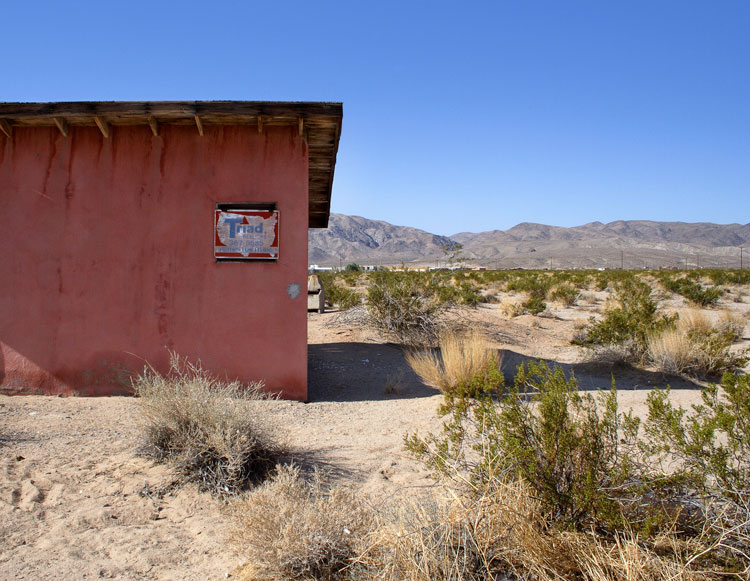Kim Stringfellow’s photographs of derelict cabins that sit within the high-desert landscape of the Mojave provide a necessarily familiar entry point into “Jackrabbit Homestead: Tracing the Small Tract Act in the Southern California Landscape.” This, the artist’s most recent project, is a bit like an iceberg with mass mostly hidden beneath the ocean’s surface: the research, digital media, photographs and other materials in the show merely hint at the full scope of her project, which digs into regional history and social movements, requires attentive listening and reading, and invites viewers to directly experience the desert.
In spite of the somewhat virtual and expansive nature of the exhibit, the photographs at the Culver Center for the Arts are the visual core of “Jackrabbit,” and they elicit an immediate draw. These images of abandoned structures succumbing to the inescapable pressures of entropy and the relentless incursions of the harsh desert environment suggest a narrative of failed dreams, yet they also reflect the idealism and pioneer spirit of the American West that set homesteaders on their hopeful track.
The subject of Stringfellow’s project, the Small Tract Act of 1938, colloquially known as the Jackrabbit Homestead Act, created opportunities for individuals to homestead federal land. The 1938 law differed substantially from the Homestead Act of 1862 with respect to the size of the homestead. Whereas the 1862 law provided for homesteads of 160 acres, Jackrabbit homesteads were only five acres. Most of the Jackrabbit homesteads were located in Southern California, concentrated in the Mojave Desert around the Morongo Valley, Wonder Valley and outside of Twentynine Palms, and were not especially suitable for cultivation due to the lack of water.
Documenting the Jackrabbit Homestead Act, a display case houses copies of Desert Magazine’s six-part series from July–December, 1950, “Diary of a Jackrabbit Homesteader,” along with a how-to article from Desert Magazine offering tips to would-be homesteaders; a copy of Five Acres of Heaven, a 1955 vanity publication showcasing the skills of a land locator for hire; and a handful of photographs of homesteaders on their claims. Stringfellow’s book, Jackrabbit Homestead, is available on a wall-mounted pedestal next to an iPod-listening station loaded with her six-part audio tour. And paired with each of Stringfellow’s 18 photos is a facsimile of the land patent—the homesteader’s equivalent of a deed of trust.
As a photographer, Stringfellow divides her attention between exteriors, which situate the cabins within the landscape, and interiors that personalize the sense of decay. Signs of occupancy, and the residue left after the owners’ departure, offer a more intricate human narrative than the iconic building-in-landscape. The exteriors find a visual precedent in John Divola’s “Isolated Houses” series (1995–98), in which Divola photographed dwellings in remote locations in roughly the same geographic location—titled by their latitude and longitude. While Divola describes “Isolated Houses” as a sign of man in the landscape, Stringfellow’s homestead exteriors are a sign of man retreating from the landscape and the indicators of his presence being re-absorbed by the desert.
Stringfellow’s photos, like Divola’s, reveal the vastness of the desert, the isolation of these modest structures and their insignificance in scale. The small size of the homestead cabins becomes clear from the Culver Center installation. The layout of a popular model—the Nugget Cabin—offered by a local construction company and illustrated on the gallery floor in black adhesive, reveals just how tight 400 square feet can be.
Stringfellow’s website includes the audio tour as a download and a companion piece for those who wish to see the remaining cabins in the open desert. The site also provides GPS coordinates of known cabins uploaded to Google Earth, and Stringfellow encourages others to upload the locations of cabins not currently documented. The inevitable demise of the remaining abandoned homestead cabins assures an end to the interactive portion of the project, which is one of the more interesting aspects of “Jackrabbit.”
Stringfellow’s project is compelling because it does not simply address questions of beauty, or why people find the desert alluring; rather, she traces people’s dreams and the tenuous relationship humans have with this extreme environment. It is sobering to note that Los Angeles is a similarly arid, (though slightly less so) region that also depends on imported water for its survival. Stringfellow’s project surveys the determination required to flourish. Her photographs, which engage in a discourse with highly romanticized images of human structures in the landscape, are both elegiac and optimistic.

